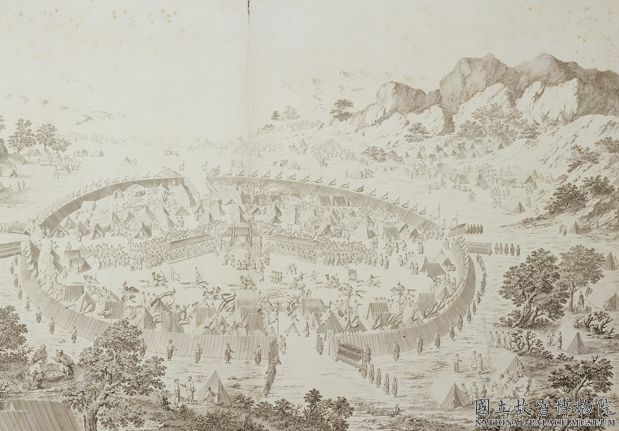[Dong Qichang’s Antique Landscape Atlas]
Antique Landscape Atlas, Ming Dynasty, Dong Qichang’s painting, paper edition, ink, 10 cm, 23.8 cm vertically and 13.7 cm horizontally
The first opening: “Xuanzai imitates Wang Shuming.” The next seal is “Dong Qichang’s seal”. The caption on the opposite picture reads: “Yimao Ziyue looks at the moon and sends the envoy to plot Wu Chang. The six scenes are written in the boat as a farewell. Dong Qichang.” The seal is “Dong Qichang” and “Tai Shi’s”. The seal of the seal is “Jin Ting’s thin fairy’s textual research” (Zhu Wenlong), etc. Yimao is the 43rd year of the Wanli period of the Ming Dynasty (1615)
The second opening paragraph: “Xuanzai imitates Huichong’s pen.” The next seal is “Dong Qichang’s seal”
The third opening paragraph: “Imitate Zhao Danian. Xuanzai.” The next seal is “Dong Qichang seal”
The fourth paragraph: “Xuanzai imitates Mi Yuanhui.” The next seal is “Dong Qichang’s seal”
The fifth paragraph: “Xuanzai imitates Huang Zijiu.” The next seal is “Dong Qichang’s seal”
The sixth paragraph: “Xuanzai imitates Yunlin.” The next seal is “Dong Qichang’s seal”
The seventh paragraph: “Xuanzai.”
The eighth paragraph: “What you see in Tongling Road, Xuanzai.” The next seal is “Dong Xuanzai”
The ninth paragraph: “Xuanzai.” The seal is “Dong Xuanzai”
The tenth paragraph: “The spring flies down quickly, and the pine branches are flat. Xuanzai.” The next seal is “Dong Xuanzai”. Wang Chang answered the question: “Painters are all learned by their natural beauty. To think of Weng, the lacquer garden is called” man is the heaven “.” man is the heaven “, just like Liezi is in the wind, who is cool. The second day after the awakening of insects, the Buddhist monk fixed the incense to read in the piano painting building, and the spring snow was still not yet finished.” The seal of “Wang”, “Chang” and “Mr. Bao Dao returned to the south of the Yangtze River with apricot flowers and spring rain” was affixed
This album is a series of landscape paintings created by Dong Qichang when he was 61 years old and lived in the south of the Yangtze River. On the basis of carefully imitating the paintings of previous painters such as Wang Meng, Hui Chong and Zhao Danian, he integrated his own aesthetic interest. Each page of the book has a scene, which is composed of mountains and trees. The composition of the painting page is of the Pingyuan style. The trees in the close view are mixed with withering and blooming, and the mountains in the long view are continuous. The middle view expands the picture space with a pool of still lake and clear water, and at the same time enriches the hierarchical changes of the scene. The mountains, rocks and trees in the picture do not seek to be realistic, but only focus on the expression of their images. Through skillful pen and ink, they not only show the charm of the landscape, but also reflect Dong’s unique understanding of the natural landscape
There are two styles in the style of the printed text, the title and the expression of the stone in this album. The first to sixth seals are “Dong Qichang seal”, and the seventh to tenth seals are “Dong Xuanzai”. The font of the first to sixth opening paragraphs is clear, vigorous, sparse and beautiful, and the style is natural, with the typical style of Dong’s cursive style; The characters from the seventh to the tenth openings are loose outside and tight inside, without the charm of the ancient and relaxed Dong characters. In the chapping and spotting of the rocks, the first to sixth Kaiduo first outlines the stone skeleton mountains with thin and simple lines, then slightly chaps the side front of the dry pen, and uses thick ink as the horizontal point of the horizontal pen. Through the dry and wet color of the ink, it shows the ethereal beauty of the washed stone lead; In contrast, the strokes of the rocks in the seventh to tenth opening pages are too stiff and stiff, lacking the subtle and elegant charm of Dong’s landscape paintings. More importantly, Dong Shi wrote in the first opening of the opposite picture: “Yimao Ziyue looked at the moon and sent the envoy to plot Wuchang, and wrote these six scenes in the boat as a departure”, which has already stated that only “six scenes are different”, not ten scenes. The atlas was identified by Mr. Xu Bangda on October 30, 1990, and it was considered that the seventh to tenth opening pages of the atlas were postdated, not the original work of Dong Qichang.
![图片[1]-Dong Qichang Antique Landscape Atlas-China Archive](https://chinaarchive.net/Ming dynasty/painting/19107[1024].jpg)
![《仿古山水图》册第一开 图片[2]-Dong Qichang Antique Landscape Atlas-China Archive](https://chinaarchive.net/Ming dynasty/painting/19094.jpg) 《仿古山水图》册第一开
《仿古山水图》册第一开![《仿古山水图》册第二开 图片[3]-Dong Qichang Antique Landscape Atlas-China Archive](https://chinaarchive.net/Ming dynasty/painting/19095.jpg) 《仿古山水图》册第二开
《仿古山水图》册第二开![《仿古山水图》册第三开 图片[4]-Dong Qichang Antique Landscape Atlas-China Archive](https://chinaarchive.net/Ming dynasty/painting/19096.jpg) 《仿古山水图》册第三开
《仿古山水图》册第三开![《仿古山水图》册第四开 图片[5]-Dong Qichang Antique Landscape Atlas-China Archive](https://chinaarchive.net/Ming dynasty/painting/19097.jpg) 《仿古山水图》册第四开
《仿古山水图》册第四开![《仿古山水图》册第五开 图片[6]-Dong Qichang Antique Landscape Atlas-China Archive](https://chinaarchive.net/Ming dynasty/painting/19098.jpg) 《仿古山水图》册第五开
《仿古山水图》册第五开![《仿古山水图》册第六开 图片[7]-Dong Qichang Antique Landscape Atlas-China Archive](https://chinaarchive.net/Ming dynasty/painting/19099.jpg) 《仿古山水图》册第六开
《仿古山水图》册第六开![《仿古山水图》册第七开 图片[8]-Dong Qichang Antique Landscape Atlas-China Archive](https://chinaarchive.net/Ming dynasty/painting/19100.jpg) 《仿古山水图》册第七开
《仿古山水图》册第七开![《仿古山水图》册第八开 图片[9]-Dong Qichang Antique Landscape Atlas-China Archive](https://chinaarchive.net/Ming dynasty/painting/19101.jpg) 《仿古山水图》册第八开
《仿古山水图》册第八开![《仿古山水图》册第九开 图片[10]-Dong Qichang Antique Landscape Atlas-China Archive](https://chinaarchive.net/Ming dynasty/painting/19102.jpg) 《仿古山水图》册第九开
《仿古山水图》册第九开![《仿古山水图》册第十开 图片[11]-Dong Qichang Antique Landscape Atlas-China Archive](https://chinaarchive.net/Ming dynasty/painting/19103.jpg) 《仿古山水图》册第十开
《仿古山水图》册第十开

![[Qing Dynasty] British female painter—Elizabeth Keith, using woodblock prints to record China from the late Qing Dynasty to the early Republic of China—1915-China Archive](https://chinaarchive.net/wp-content/uploads/2022/11/image-191x300.png)



